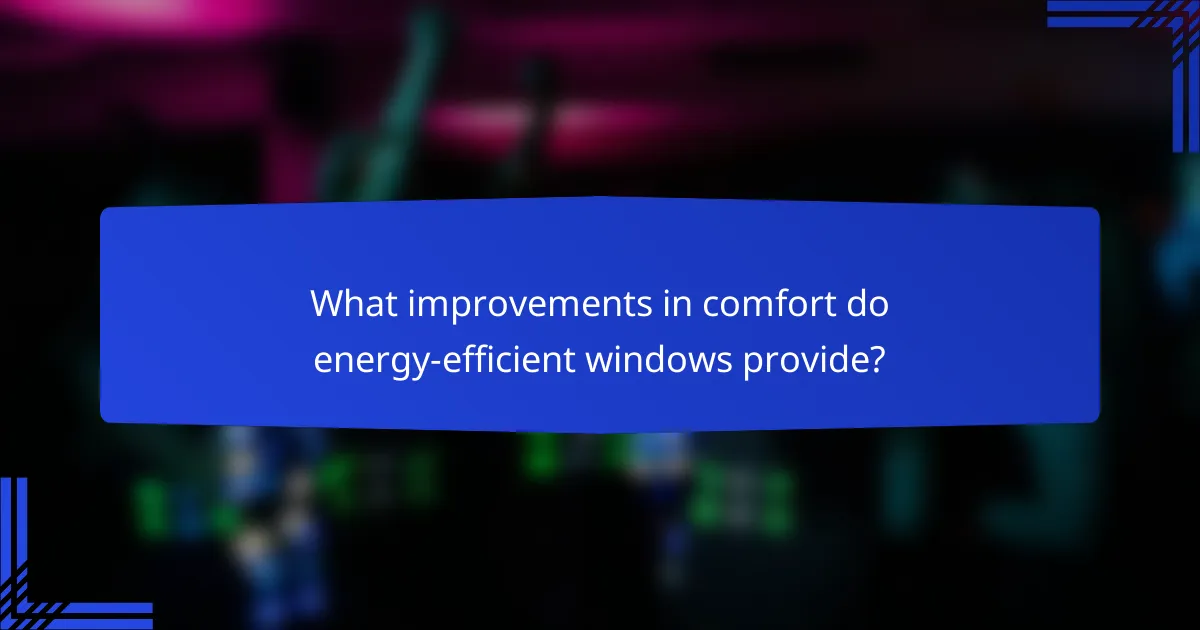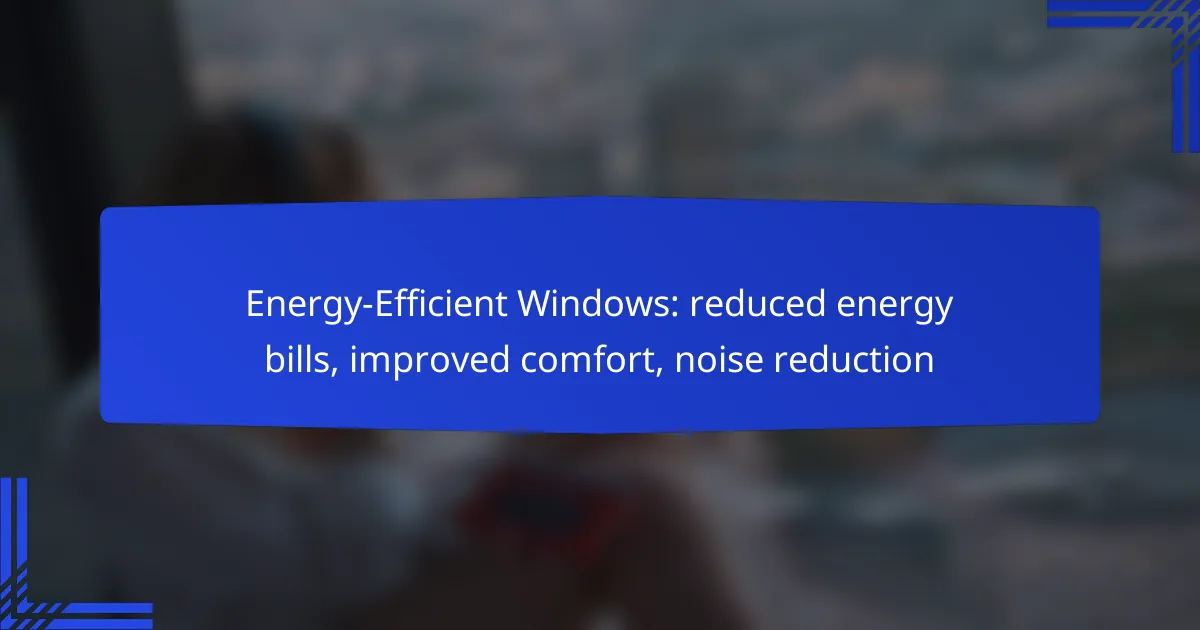Energy-efficient windows are an excellent investment for homeowners, as they significantly lower energy bills by minimizing heat loss in winter and reducing heat gain in summer. By utilizing advanced materials and designs, these windows not only enhance insulation but also improve indoor comfort by maintaining consistent temperatures and reducing noise levels, creating a more pleasant living environment year-round.

How do energy-efficient windows reduce energy bills?
Energy-efficient windows lower energy bills by minimizing heat loss in winter and reducing heat gain in summer. They achieve this through advanced materials and designs that enhance insulation and reduce reliance on heating and cooling systems.
Low U-factor ratings
Low U-factor ratings indicate better insulation properties in windows, meaning they transfer less heat. A U-factor below 0.30 is generally considered energy-efficient, helping to maintain indoor temperatures and reduce heating and cooling costs.
When selecting windows, look for those with a low U-factor, as they can significantly impact your energy bills. This rating is especially crucial in regions with extreme temperatures, where energy savings can be substantial.
Insulating gas fills
Insulating gas fills, such as argon or krypton, are used between the panes of double or triple-glazed windows to enhance thermal performance. These gases are denser than air, reducing heat transfer and improving energy efficiency.
When choosing windows, consider those filled with these gases for better insulation. They can improve energy efficiency by up to 30% compared to standard air-filled windows, making them a worthwhile investment.
Low-E coatings
Low-E (low emissivity) coatings are thin layers applied to window glass that reflect infrared light while allowing visible light to pass through. This helps keep indoor spaces warm in winter and cool in summer, further reducing energy consumption.
Look for windows with Low-E coatings to enhance energy efficiency. These coatings can reduce energy bills by reflecting heat back into the room during colder months and blocking unwanted solar heat in warmer months.

What improvements in comfort do energy-efficient windows provide?
Energy-efficient windows enhance comfort by maintaining consistent indoor temperatures, reducing noise, and minimizing drafts. These windows are designed to limit heat transfer, ensuring a more stable and pleasant living environment throughout the year.
Temperature regulation
Energy-efficient windows help regulate indoor temperatures by utilizing advanced glazing technologies, such as low-emissivity (Low-E) coatings and multiple panes. These features reflect heat during the summer and retain warmth in winter, leading to a more comfortable living space.
For optimal performance, consider windows with a U-factor below 0.30, which indicates better insulation. This can lead to noticeable reductions in heating and cooling costs, often translating to savings of 10-25% on energy bills.
Reduced drafts
By sealing gaps and utilizing high-quality materials, energy-efficient windows significantly reduce drafts that can disrupt indoor comfort. Proper installation is crucial to ensure that these windows perform effectively in blocking unwanted air leaks.
Look for windows with a high air leakage rating, ideally below 0.3 cubic feet per minute per square foot. This can prevent cold air from entering during winter and hot air during summer, enhancing overall comfort and energy efficiency in your home.

How do energy-efficient windows contribute to noise reduction?
Energy-efficient windows significantly reduce noise by incorporating specialized materials and designs that limit sound transmission. These windows create a more peaceful indoor environment, making them ideal for homes in noisy areas such as near highways or busy streets.
Soundproofing features
Soundproofing features in energy-efficient windows include thicker glass, laminated glass, and insulated frames. These elements work together to absorb and block sound waves, reducing the amount of noise that enters a home. For example, laminated glass consists of a layer of plastic sandwiched between two sheets of glass, which enhances sound dampening.
Additionally, the use of airtight seals and weatherstripping around the window frame prevents sound leaks. Proper installation is crucial; poorly installed windows can negate the benefits of soundproofing features.
Double or triple glazing
Double or triple glazing refers to windows with two or three layers of glass, respectively, separated by gas-filled spaces. This design not only improves thermal insulation but also enhances sound insulation. The gas, often argon or krypton, further dampens sound vibrations, making these windows particularly effective in reducing external noise.
When choosing between double and triple glazing, consider the level of noise pollution in your area. For environments with high noise levels, triple glazing may provide superior soundproofing, while double glazing is often sufficient for moderate noise. Always ensure that the glazing is installed correctly to maximize its noise reduction capabilities.

What are the key features of energy-efficient windows?
Energy-efficient windows are designed to minimize heat loss and gain, leading to reduced energy bills and improved indoor comfort. Key features include advanced frame materials and specialized glazing options that enhance thermal performance and noise reduction.
Frame materials
The choice of frame materials significantly impacts the energy efficiency of windows. Common materials include vinyl, wood, fiberglass, and aluminum, each offering different thermal properties and maintenance needs. For instance, vinyl frames are known for their excellent insulation and low maintenance, while wood frames provide aesthetic appeal but may require more upkeep.
When selecting frame materials, consider factors like durability, insulation value, and local climate. In colder regions, frames with better thermal resistance can help maintain indoor temperatures and reduce heating costs.
Glazing options
Glazing options refer to the type of glass used in windows, which plays a crucial role in energy efficiency. Double or triple glazing, which consists of two or three panes of glass with insulating gas between them, significantly reduces heat transfer compared to single-pane windows. Low-emissivity (Low-E) coatings can further enhance performance by reflecting heat back into the room during winter and blocking solar heat in summer.
When choosing glazing, consider the U-factor and Solar Heat Gain Coefficient (SHGC) ratings. A lower U-factor indicates better insulation, while a lower SHGC means less solar heat enters the home. For optimal performance, select glazing that aligns with your local climate and energy efficiency goals.

What are the best brands for energy-efficient windows in the UK?
The best brands for energy-efficient windows in the UK include Velux, Andersen, and Marvin. These manufacturers are known for their high-quality products that enhance energy efficiency, reduce energy bills, and improve overall comfort in homes.
Velux
Velux specializes in roof windows and skylights that are designed to maximize natural light while minimizing heat loss. Their products often feature triple glazing and advanced insulation techniques, making them a popular choice for energy efficiency.
When considering Velux windows, look for models with a high energy rating. Many of their products meet or exceed UK building regulations for energy efficiency, which can lead to significant savings on heating costs.
Andersen
Andersen offers a range of window styles, including double-hung and casement windows, with a focus on energy-efficient features. Their windows often incorporate Low-E glass, which helps to reflect heat back into the home during winter and keep it out during summer.
Choosing Andersen windows can be beneficial for homeowners looking to reduce their carbon footprint. Their products are designed to provide excellent thermal performance, which can contribute to lower energy bills over time.
Marvin
Marvin is known for its customizable window solutions that combine aesthetics with energy efficiency. Their windows are built with durable materials and advanced glazing options that enhance insulation and reduce noise pollution.
When selecting Marvin windows, consider their energy performance ratings and available features like argon gas fills and low-emissivity coatings. These elements can significantly improve comfort levels and energy savings in your home.

What factors should you consider when selecting energy-efficient windows?
When selecting energy-efficient windows, consider factors such as climate suitability, building regulations, and the specific features of the windows that impact energy performance. These elements collectively influence energy bills, comfort levels, and noise reduction in your home.
Climate suitability
Climate suitability is crucial when choosing energy-efficient windows, as different window types perform better in specific weather conditions. For example, double-glazed windows are often ideal for colder climates, while low-emissivity (low-E) coatings can help reflect heat in warmer areas.
Evaluate the local climate to determine the best window features. Regions with high humidity may benefit from windows that reduce condensation, while areas with extreme temperatures should prioritize insulation and solar heat gain coefficients.
Building regulations
Building regulations can dictate the minimum energy efficiency standards for windows in your area. Familiarize yourself with local codes to ensure compliance, as these regulations often aim to reduce energy consumption and improve overall building performance.
In many areas, energy-efficient windows must meet specific ratings, such as the National Fenestration Rating Council (NFRC) labels in the United States or similar standards in Europe. Check these ratings to compare window performance and make informed decisions that align with legal requirements.
